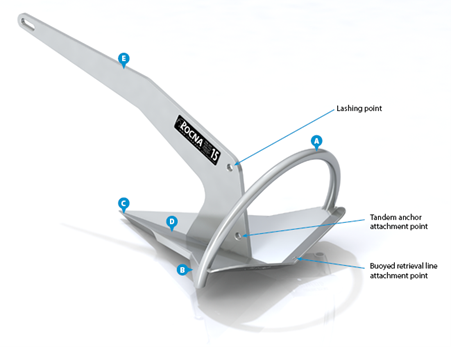-min.jpg?width=800&name=My%20project-1%20(5)-min.jpg)
© Rocna Anchor
As a sailor, you know the importance of having a good anchor. With so many different anchors on the market, it can be hard to decide which one is right for you.
What to look for in a good anchor?
Anchors of today have several key features that make them more effective than older products. Having a concave profile (a similar shape to that of a shovel) ensures a firm hold is established on the sea-bed, rather than just ploughing through the sea-bed like some other models.
Another key design feature in an anchor is having enough tip weight to ensure weed and various sea-beds can be pierced to form a suitable grounding. Ideally you want 35 – 45% of the weight in the tip of the anchor, and a way to ensure it grounds in the correct orientation and cannot capsize.
So how does the Rocna Anchor weigh up?
The Rocna Anchor was developed by a sailor called Peter Smith who experienced many issues with anchors and could not understand the need to have a number of different anchors to cope with various sea-beds. In search of the perfect anchor to provide ‘reliability, security and confidence’, and using his lifetime of nautical experience, he developed the Rocna Anchor.
© Rocna Anchor
Key features of the Rocna Anchor:
The Rocna Anchor has a roll bar (A) which ensures that the anchor arrives at the ideal angle, and the setting skids (B) guide the fluke tip (C), which acts as a sharp point to cut into the seabed. Most of the anchor’s weight is in the fluke tip ensuring a reliable set every time.

© Rocna Anchor
The fluke (D) is concave providing the greatest resistance and largest fluke area possible. This provides the holding power to secure the boat on soft sea-beds. When the floor is harder or weedy Rocna’s chisel tip (C) cuts through the surface and drives down to get a secure grip.
Buoyed retrieval line
Although in normal conditions the Rocna is easily recovered there are always going to be some instances where the anchor can become caught on rocks, cables or coral. When this occurs it can become difficult to retrieve your anchor and applying a greater force can lead to damage to the anchor or associated equipment. This is where the buoyed retrieval line can come into play. By attaching a small buoy or other flotation device to the Rocna's dedicated attachment point the buoy will then float directly above the anchor. If attempts to retrieve the anchor fail, the buoy may be picked up and the anchor lifted ‘backward’ using the retrieval line.
Lashing Point
The hole in the shank above the tandem anchor attachment point is ideal to use when lashing the anchor. By using rope it can be easily tied and tightened, and is easily undone or cut if necessary.
Tandem Anchor Attachment Point
The Rocna has a dedicated attachment point for the use of a tandem anchor in storm or hurricane conditions. The two anchors can then work together in unison with a more even distribution of the load.
Other key features:
Versatility - the multipurpose anchor is suitable for the majority of sea-beds.
Strength and durability - through high tensile steel shank (E)
Self–deploying and Self–recovering – the shank design of the Rocna enables the majority of bow-rollers to stow and deploy the anchor with ease.
Guaranteed for life - against both breakage and bending in addition to manufacturing defects.
Conclusion
The anchor and material you choose depends heavily on a number of factors; weight, type of sailing, storage and sea-bed. The Rocna Anchor is a great all rounder, perfect for cruising with the ability to set on various sea-beds and has 14 sizes from 4 kg (9 lb) – 275 kg (606 lb).
If you have any questions about Rocna anchors, please feel free to email us at support@upffront.com, or click the link below to see our full range:



